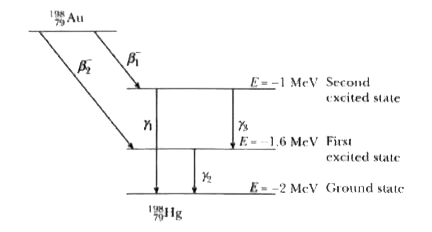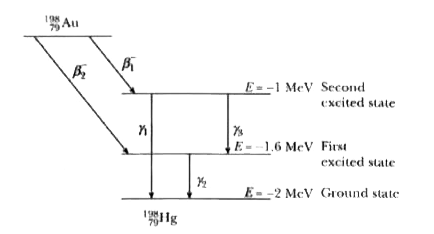PRACTICE QUESTIONS (Linked Comprehension) from RESNICK AND HALLIDAY PHYSICS Chapter 35 THE NUCLEUS for Class 12
| Class 12 | PHYSICS |
| Chapter | THE NUCLEUS |
| RESNICK AND HALLIDAY PHYSICS | PRACTICE QUESTIONS (Linked Comprehension) |
| Medium | English |
| Academic Year | 2023-2024 |
Question 1
Gold nucleus (19879Au) can decay into mercuyr nucleus (19880Hg8) by two decay schemes shown in figure below (i) it can emit a β -particle (β1) and come to ground state by either emiting one γ- ray (γ1) or emitting two γ- rays (γ3 and γ4) (ii) It can emit one β- particle (β2) and come to ground state by emitting γ2 ray. Atomic masses: 198Au=197.9652 amu and 198Hg=197.9662 amu. Given that 1 amu= 930MeV/c2. The energy levels of the nucleus are shown in figure below

Whatis the maximum kinetic energy of emitted β2 particle?View SolutionQuestion 2
Gold nucleus (19879Au) can decay into mercuyr nucleus (19880Hg8) by two decay schemes shown in figure below (i) it can emit a β -particle (β1) and come to ground state by either emiting one γ- ray (γ1) or emitting two γ- rays (γ3 and γ4) (ii) It can emit one β- particle (β2) and come to ground state by emitting γ2 ray. Atomic masses: 198Au=197.9652 amu and 198Hg=197.9662 amu. Given that 1 amu= 930MeV/c2. The energy levels of the nucleus are shown in figure below

What is the maximum kinetic energy of emitted β1 parricle ?View SolutionQuestion 3
Gold nucleus (19879Au) can decay into mercuyr nucleus (19880Hg8) by two decay schemes shown in figure below (i) it can emit a β -particle (β1) and come to ground state by either emiting one γ- ray (γ1) or emitting two γ- rays (γ3 and γ4) (ii) It can emit one β- particle (β2) and come to ground state by emitting γ2 ray. Atomic masses: 198Au=197.9652 amu and 198Hg=197.9662 amu. Given that 1 amu= 930MeV/c2. The energy levels of the nucleus are shown in figure below

The wavelength of emitted γ - rays is the orderView SolutionQuestion 4
We have two radioactive nuclei A and B. Both convert into a stable nucleus C. Nucleus A converts into C after emitting two two α-particles and three β-particles. Nucleus B converts into C after emitting one.
α-particle anf five β-particles. A time t=0, nuclei of A are 4N0 and that of B are N0. Half-life of A(into the conversion of C) is 1min and that of B is 2min. Initially number of nuclei of C are zero.
If atomic numbers and mass numbers of A and B are Z1,Z2,A1 and A2 respectively. Then View SolutionQuestion 5
We have two radioactive nuclei A and B. Both convert into a stable nucleus C. Nucleus A converts into C after emitting two two α-particles and three β-particles. Nucleus B converts into C after emitting one.
α-particle anf five β-particles. A time t=0, nuclei of A are 4N0 and that of B are N0. Half-life of A(into the conversion of C) is 1min and that of B is 2min. Initially number of nuclei of C are zero.
What are number of nuclei of C, when number of nuclei of A and B are equal ?View SolutionQuestion 6
We have two radioactive nuclei A and B. Both convert into a stable nucleus C. Nucleus A converts into C after emitting two two α-particles and three β-particles. Nucleus B converts into C after emitting one.
α-particle anf five β-particles. A time t=0, nuclei of A are 4N0 and that of B are N0. Half-life of A(into the conversion of C) is 1min and that of B is 2min. Initially number of nuclei of C are zero.
At what time rate of disintergrations of A and B are equal.View SolutionQuestion 7
In a nuclear fusion reactor, the reaction occurs in two stages (i) Two deuterium (21D) nuclei fuse to form a tritium (31T) nucleus with a proton as a byproduct. The reaction may be represented as D (D,p) T. (ii) A tritium nucleus fuses with another deuterium nucleus to form a helium (42He) nucleus with a neutron as a byproduct. The reaction is represented as T(D.n)α. Given that m(21d)=2.014104u (atom)
m(31T)=3.01609u (atom)
The energy released in 1st stage of fusion reaction is View SolutionQuestion 8
In a nuclear fusion reactor, the reaction occurs in two stages (i) Two deuterium (21D) nuclei fuse to form a tritium (31T) nucleus with a proton as a byproduct. The reaction may be represented as D (D,p) T. (ii) A tritium nucleus fuses with another deuterium nucleus to form a helium (42He) nucleus with a neutron as a byproduct. The reaction is represented as T(D.n)α. Given that m(21d)=2.014104u (atom)
m(31T)=3.01609u (atom)
The energy released in the second stage of fusion reactionView SolutionQuestion 9
In a nuclear fusion reactor, the reaction occurs in two stages (i) Two deuterium (21D) nuclei fuse to form a tritium (31T) nucleus with a proton as a byproduct. The reaction may be represented as D (D,p) T. (ii) A tritium nucleus fuses with another deuterium nucleus to form a helium (42He) nucleus with a neutron as a byproduct. The reaction is represented as T(D.n)α. Given that m(21d)=2.014104u (atom)
m(31T)=3.01609u (atom)
What percentage of the mass energy of the initial deuterium is released? View SolutionQuestion 11
Consider the following nuclear decay: 23692U→23490Th+X
Determine the amount of energy released in this decay. Use the following atomic masses.
23692=236.045562u,23290Th=232.038054u
42He=4.002603u,10n=1.008665u and 11p=1.007277h
Conversion factors 1u=931.5meV,1eV=1.602×10−19J View Solution